Dame Agatha Christie apparently disliked most of the movies adapted from her work, not without reason in some cases, though there are several honourable exceptions. Particularly worthy of note are the blackly comic 1945 version of And Then There Were None and Billy Wilder’s near-perfect rendition of her theatrical whodunit, Witness for the Prosecution (1957). The most financially successful however remains Murder on the Orient Express (1974) from the producing team of Richard Goodwin and John Brabourne. Its success launched a series of star-studded period films made from her books and lead more directly to three follow-up films from the same team. The first, Death on the Nile (1978) is perhaps the best of the bunch but it made less money than its predecessor, which may explain why they decided on a change of tack for their next film. In fact they moved away from the exotic Poirot novels set overseas for the more traditional British country village setting of a Miss Marple mystery. The resulting film, The Mirror Crack’d (1980), is easily the least well-known of the quartet (the other was Evil Under the Sun (1982) which returned to Poirot and foreign climes). And yet, in many ways, it deserves to be savoured as the most daring and original of this brief series – and certainly as the funniest.
“I could eat a can of Kodak and puke a better movie” – Lola Brewster (Kim Novak)
Originally published in 1962, the novel is changed quite considerably and relocated to 1953, the year of the coronation of Queen Elizabeth II and is now set during the making of a movie about the first Elizabeth and Mary Queen of Scots, the latter to be played by movie legend Marina Rudd (Elizabeth Taylor). Set in the world of movie make-believe, this is a murder mystery for connoisseurs that both revels in the conventions of the genre while gently poking fun at them too.
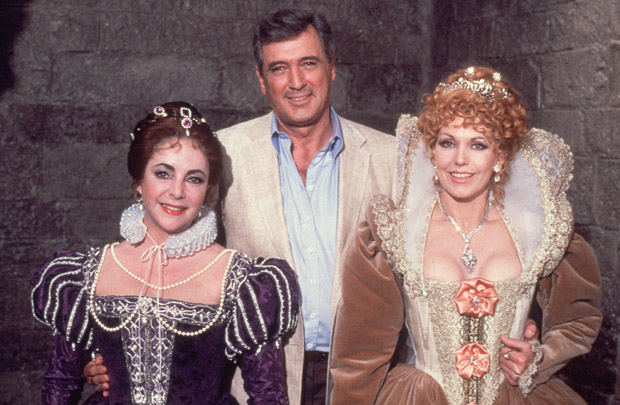
Elizabeth Taylor, Rock Hudson and Kim Novak in THE MIRROR CRACK’D (1980 © Associated Film Distribution)
It begins in glorious black and white with an external shot of an opulent country home (which is clearly a model). Everyone speaks in cut-glass accents and acts very stiffly indeed – a murder has been committed and Inspector Gates (Nigel Stock) has gathered all the suspects together to reveal the murderer. Just as he is about to name the culprit … the film breaks down and we cut to the village hall in St Mary Mead (now in colour). It turns out that we have been watching the ending of ‘Murder at Midnight’, a (fictitious) mystery movie starring Anthony Steel and Dinah Sheridan, two actors who acted in movies just like this at that time. It is left to Miss Marple, played by a pre-Jessica Fletcher Angela Lansbury, to reveal the identity of the (movie) murderer.
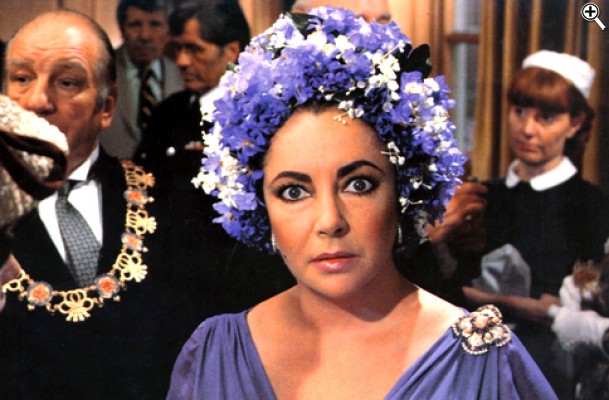
Elizabeth Taylor in THE MIRROR CRACK’D (1980 © Associated Film Distribution)
This extended pre-credits teaser is a charming touch and alone is worth the price of admission to fans of 50s British movies, perfectly setting the mood as director Guy Hamilton expertly recreates the tone and style of the mysteries that he was making at around that time such as The Ringer (1952) and An Inspector Calls (1954). By giving us the traditional rounding up of the suspects climax at the beginning rather than at the end – albeit an interrupted one – it signals that this film plans to play a little with traditional viewer expectations. Indeed, this is certainly not a film to please fans of the traditional Christie story – quite the opposite in fact, though in many ways this is a really intelligent way to adapt a book infused with movie lore. Not only did Christie dedicate the original novel to Margaret Rutherford – then playing Marple in a series of four films – but the motive for the murder of seemingly innocent movie fan Heather Babcock was in fact based on something that actually happened to legendary 40’s film star Gene Tierney.
I must admit, when I first saw this film at the cinema on its original release, I distinctly remember, at the tender age of 12, being very disappointed with it. It didn’t help that I kept comparing it with Death on the Nile which preceded it. I had liked that movie a good deal 9and still do) for its clever plot construction, gorgeous Jack Cardiff cinematography on Egyptian locations, fabulous 1930s costumes and decor and the majestic music of Nino Rota. By comparison, The Mirror Crack’d just felt incredibly small and parochial and its melancholy finale felt like a real anti-climax. As the years have passed though, I’ve come to re-assess it. Like Mike Hodges’ Flash Gordon (1980), another film released around that time that I remember being really disappointed by, it seems to me to have got funnier as the years have passed.
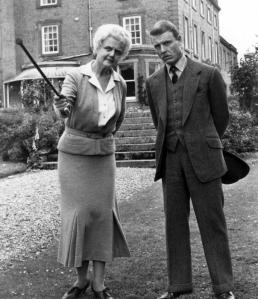
Angela Lansbury and Edward Fox in THE MIRROR CRACK’D (1980 © Associated Film Distribution)
As the movie-within-a-movie opening makes clear, this is in fact a film that guys the whole whodunnit genre. For example, the way that the Edward Fox character is introduced, all ominous shadows and low angles, only for him to be revealed as Inspector Craddock, the ‘favourite’ nephew of Miss Marple; or the scene in which Taylor goes over the top while being questioned by the police, the camera tracking in as she seemingly reaches a pitch of paranoid hysteria, only to be caught out by Fox who recognises the dialogue as being from one of her earlier movies, at which point she bursts into gales of laughter. Equally, the fact that Miss Marple’s final deductions come far too late and make no difference at all, concluding quietly and a little flatly, is precisely because we were told at the beginning of the film that the traditional, Poirot-like rounding up of the suspects and long-winded explanations were a silly convention when the black and white movie broke down and Miss Marple provided the correct, but decidedly undramatic, solution. Most of the fun therefore derives from the witty dialogue and situations created by the disruptive injections of a Hollywood movie company into St Mary Mead.
Lansbury was probably a bit young for the role at the time and as a result is perhaps giving too studied a character performance, though again with the passing of time I find myself persuaded that technically she actually gives an excellent performance. The rest of the cast doesn’t have to stray too far from established parameters though. Kim Novak is cast as Elizabeth I (!) by her producer boyfriend Tony Curtis and gets the pick of the bitchy dialogue, mainly written one presumes by Barry Sandler, the author of such camp classics as Making Love (1982) and Ken Russel’s noir maudit, Crimes of Passion (1984). Rock Hudson is as ever utterly reliable as the director trying to cope with an unstable wife and unstable movie production, while Geraldine Chaplin, as the secretary secretly in love with him, gets a spectacularly nasty death scene. There are tons of great British character actors and even a young Pierce Brosnan can briefly be spotted being clutched to la Taylor’s bosom when she’s playing Elizabeth I in the studio (definitely a step up in my book from the IRA killer he had previously played in The Long Good Friday!) Charles Gray even pops up as a butler, while Fox has a great time as the movie-obsessed but quite shrewd inspector. His soft-spoken prodding (and puncturing on occasion) of the Hollywood suspects is nicely contrasted with the low-key discussions in which he goes over the case with his aunt, who here takes a back seat after straining her ankle. She rallies for a final resolution, but as I say, in fact arrives far too late to make any difference.
To me this is a clever and knowing movie, one that at times gets even quite close to parody without crossing over – but which perhaps went too clearly against audience expectations for real popular success. In many ways the next and final one of the sequence, Evil Under the Sun, is probably the one that most amiably combines the traditional Christie structure with parodic characters and dialogue without straying too far from the genre path. Christie’s 1962 novel has since been adapted for television with both Joan Hickson and Julia McKenzie as Miss Marple (the latter version using Christie’s full title, The Mirror Crack’d from Side to Side) – neither for my money is as imaginative, funny or clever as the 1980 movie version.
DVD Availability: Available on DVD and Blu-ray worldwide.
The Mirror Crack’d (1980)
Director: Guy Hamilton
Producer: Richard Goodwin, John Brabourne
Screenplay: Barry Sandler, Jonathan Hales (from the novel by Agatha Christie)
Cinematography: Christopher Challis
Art Direction: Michael Stringer
Music: John Cameron
Cast: Angela Lansbury (Miss Marple), Elizabeth Taylor, Rock Hudson, Tony Curtis, Kim Novak, Geraldine Chaplin, Edward Fox, Charles Gray
This review is offered as part of the Tuesday’s Overlooked Film meme hosted by Todd Mason over at his Sweet Freedom blog and you should head over there to see the many other fascinating titles that have been selected.

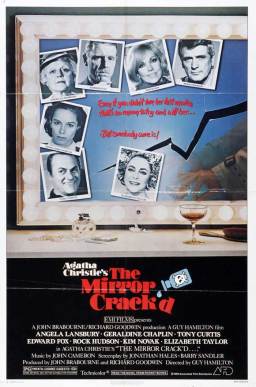
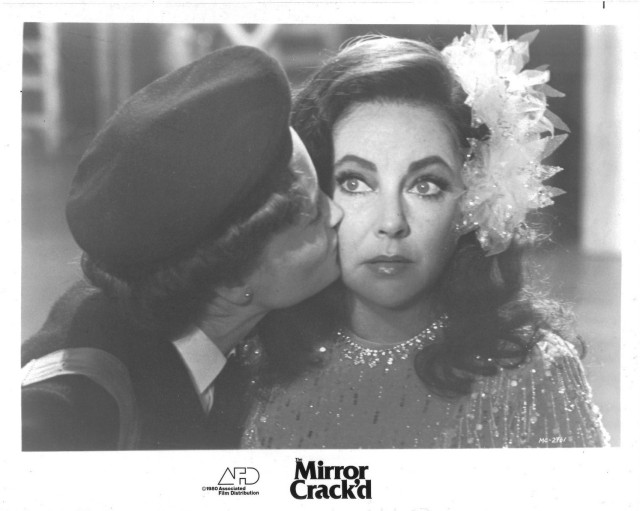


I avoided this movie for the longest time, but when I finally got around to watching it I found it very enjoyable. There’s an undeniable element of camp, but the camp plays against the tragedy in interesting ways; I think Rock Hudson gives a slam-dunk performance, particularly in those final scenes.
It’s still a shock to see Miss Marple smoking up a storm toward the end of the movie, though….
I know, the smoking just feels plain wrong somehow and yet clearly makes the Marple character much more plausible and of her time – and you’re certainly right about the way that the comedy offsets the melancholy and tragedy of the story – thanks for the comments Nathanael, much appreciated.
Great review, Sergio! I enjoyed reading it right down to your take on how each of the actors pan out in this film. I haven’t seen movies based on Agatha Christie’s novels for a while now and your post tells me I’ve been missing something. I remember liking MURDER ON THE ORIENT EXPRESS but that was a long time ago. I didn’t know Guy Hamilton had directed THE MIRROR CRACK’D. That’s rather unusual for one who hopped onto the Bond bandwagon quite successfully not to mention a few WWII films including MAN IN THE MIDDLE set in India and starring Robert Mitchum. It’s obvious he liked to experiment. Most of Hamilton’s films are dotted with a fine star cast and your film in question is proof that he had taste. Just how old is Brosnan in the film?!
Well, Brosnan was but a wee lad of 26 when the movie was shot. Hamilton is a pretty interesting director (and still with us, turned 89 this year) – he was one of the great First Assistants in the business, working for such tyros as John Huston on The African Queen and Carol Reed on The Third Man before becoming a director in his own right – and a really great craftsman if you look at films like Funeral in Berlin and The Colditz Story for instance. Thanks very much for the comments Prashant.
I saw all of these at the theater. They tended to be overly star-studded (which can take me out of a movie with people buzzing about how good or bad someone looks all around me) but great production values and good use of the original source.
Hi Patti – yes, I know what you mean about the casts, especially in the case of ORIENT EXPRESS which does feel like a succession of star turns, which may be why I prefer the subsequent films which take a funnier, less solemn approach (though there is also plenty of humour on the Finney movie). I mised EXPRESS at the cinema but then saw all the rest when they came out. In fact, I think as a result that I saw ORIENT EXPRESS last, which may be why I like it a bit less than the others – hmmm, not very scientific of me!
A fabulous review, Sergio. I hadn’t seen this film since once upon a time and have to say, didn’t like it much. It’s all that Hollywood hoopla type of casting that throws me off as well.
But your review has convinced me to watch it again. I believe it is currently available for ‘streaming’ from Netflix.
Of the other Christie films you mentioned, I must say that EVIL UNDER THE SUN and DEATH ON THE NILE win the day for me. Though I enjoyed MURDER ON THE ORIENT EXPRESS, I hated the soundtrack and didn’t love Albert Finney as a sort of frightening Poirot caricature.
EVIL UNDER THE SUN has such light-hearted watercolor opening credits plus charming Cole Porter music which practically steals the film from under the nose of Peter Ustinov. But the scene in which Ustinov as Poirot parades down to the sea in an outrageous bathing suit (monogrammed, of course), robe and bathing cap, steal the movie back.
Just gorgeous costuming AND setting. The only one in the cast who didn’t quite gel was James Mason, but what the heck – that’s a minor quibble. For me, Sylvia Miles as Mason’s wife makes the whole movie. She is a total nasty delight.
(By the by, I’m talking about a Rock Hudson movie today on my blog, as well.)
Rock definitely Rocks today! Thanks for all the good words Yvette – Evil Under the Sun is in many ways my real favourite of the quartet, even if the plot is basically a retread of Death on the Nile, as is part of the cast of course with the return of Ustinov, Maggie Smith and Jane Birkin as well as costume designer Anthony Powell. I love the waltz that Richard Rodney Bennett composed for Orient Express though so I’ll have to disagree with you on that ‘score’ (ho ho).
The Miss Marple books doe tend to be a bit less show-offy than the Poirot ones – understandably, given the characters of the sleuths. I liked this film – I think everyone is very well cast, and it’s not as “starry” as the earlier films. I must have seen Evil Under the Sun before, but don’t remember it – I did like Ustinov as Poirot (though I thought Finney did an excellent job with a rather atypical Poirot performance in Express – and I agree with you about the music for that film).
Hi Ela, thanks very much for the comments. The movie-making backgroud probably makes this the only one of the Marple stories that would lend themselves to the ‘guest star’ approach of these films but as you say, it doesn’t feel heavy handed though it becomes quite clear that with the main exceptions of Taylor and Hudson, the other star names are locked in to certain sequences only. John Cameron also wrote a lovely, lilting theme tune for this film – it’s a shame that it’s the only one of the the quartet that has never had the soundtrack official released.
Pingback: The Mirror Crack’d (1980) – Tuesday’s Forgotten Film | Woodymcbreairty's Blog
I have read the book and also seen the film and I regard both as brilliant. It is one of my favourite Miss Marple.
There is also a Bengali film adaptation Shubho Mahurat (2003) in Indian settings. Miss Marple is replaced by Ranga Pishima. The victim Kakoli does not die immediately but some hours later at her residence. Hence it takes some time to establish that the poisoning took place at the party.
It is a brilliant film and won the National film award for the best feature film in Bengali in 2003. There is a tragic tale regarding its brilliant director Rituparno Ghosh.
Rituparno Ghosh had a gender identity problem (female trapped in male body or some such thing). As long as his parents were alive he suppressed his feelings so that they may not face social ridicule. He did not marry. After both his parents passed away, he came out of the closet and started cross-dressing, inviting ridicule. In 2011, at the age of 47, he underwent breast implants and other operations and started taking female hormones. However, these created complications in his body and he died after a massive heart attack in 2013 at the age of 49. His friend Prosenjit Chatterjee had warned him against such surgeries and treatments but he was adamant.( http://newseastwest.com/filmmaker-rituparno-ghosh-was-adamant-on-changing-his-sex-says-prosenjit-chatterjee/ )
Fascinating to hear about the film, but how tragic for Ghosh to have died so young – it is a constant reminder that more needs to be done when one hears about people who are not been able to open about who they are. Thanks again Santosh.
Just caught the film again on TV, having avoided it for years because I had thought it so bad at first sight – possibly compared to the Joan Hickson Marples, which I think were definitive – at least in her performance. Your review interested me. Slight error in that you reverse the casting of Taylor as Mary Queen if Scots and Novak as Elizabeth. Maybe I always hated it as it was the only one of the four I did not see in the cinema first. It is too big for TV. Apart from the scene when Craddock/Fox catches her out and the short scene with Brosnan, Taylor leaves me cold – have always disliked her voice and don’t understand why she spent so much of her life with that unattractive hair style – she looks beautiful only in the scene as Mary. All the wigs terrible. It all feels so artificial but, perhaps, as you say, that was meant.
Love the Orient Express waltz and the scenery of Death on the Nile. Ustinov and Finney both too big and shambly for Poirot.
So sad to learn of Tierney’s tragedy.
Thanks Rosemary and clearly I need to update my entry!
Pingback: The Notorious Landlady (1962) | Tipping My Fedora
MIRROR is one of my favourite awful movies of all time. Really badly written and directed with major, major Hollywood alumni hamming it up like there’s no tomorrow: Taylor cackles like a demented witch, Lansbury in bosom hugging cardigans chews up the scenery, Curtis gives one of the most vulgar caricatures in movie history, and the stunning Novak appears to be giving an early audition for her upcoming year on Falcon Crest. Morbidly fascinating.
Then we are not in agreement Michael 😉
Nice to see you are still lurking, Sergio. I missed you saying you were retiring and want to take this opportunity to wish you well. By the way, did you ever take the young family to the hoot that is the 39 Steps? I have taken my teenager to some of the touring Christies and he has loved them – which shows we should not be too snobby about unsophisticated entertainment. I have yet to see Brannagh’s Poirot – I think Suchet’s was definitive like Hickson’s Marple. All best x
My identity seems to have changed. This is Rosemary
Hi Rosemary, thanks for the kind words. Yes, lurking is definitely the word – I do dip in very occasionally, but that is pretty much it. Not managed 39 STEPS yet but they are back in July so I hope to be able to take them then – it’ll be a chance for them to have some quality uncle time and give their parents a chance to catch up with some old friends on their own. I love Suchet on TV but Branagh was in my view really terrific. Incidentally, a late 2018 release date has been set for his version of DEAHT ON THE NILE now 🙂 All the best, Sergio
Thanks for that tip Sergio. The original Death on the Nile was a really sumptuous cinema trip so it will be interesting to compare. Rosemary
“The resulting film, _The Mirror Crack’d_ (1980), is easily the least well-known of the quartet. … And yet, in many ways, it deserves to be savoured as the most daring and original of this brief series – and certainly as the funniest.”
Ordinarily, I’m a ‘reasonable people can agree to disagree’ kinda gal, but I must admit to being gobsmacked as I read the words above. For me, _The Mirror Crack’d_ was awful when I saw it in theatres as a 10 year-old back in 1980, and it was just as awful when I watched it this past week, as part of the Britbox streaming subscription that a friend bought me for my 50th birthday.
Because my single-parent mom — and the various babysitters who watched me while Mom worked two jobs and attended grad school — often took me to adult films when I was a kid, I’d developed an appreciation for quality films by the time I was 7 or 8. By age 10 in 1980, I was a hard-bitten cinema-goer who not only enjoyed adult fare, but also sought out film reviews on TV (e.g. Gene Shalit on the _Today_ show) and in the local paper.
Among the ‘prestige’ films released in 1980 that I remember going to see and considering good? _Ordinary People_. _Raging Bull_. _Coal Miner’s Daughter_. _The Elephant Man_. _Melvin and Howard_. _Atlantic City_. Quality comedies? _Airplane!_ — which I loved so much that I begged to be taken to see it repeatedly. _Private Benjamin_. _The Blues Brothers_. _Nine to Five_. _Stir Crazy_. Great genre movies, regardless of budget — including films that I knew weren’t ‘highbrow’ but found so fun that I didn’t care? _The Shining_. _The Changeling_. _The Fog_. _Alligator_ (ghost-written by the great John Sayles). _Friday the 13th_. ‘Sleeper’ films that I enjoyed and felt weren’t getting enough critical love? _The Long Riders_, a haunting film that I dug despite my usual dislike of Westerns. _Resurrection_ (I’d loved Ellen Burstyn since _Alice Doesn’t Live Here Anymore_, a film near to my heart as a kid being raised by a single mom). _Return of the Secaucus Seven_.
In the midst of 1980’s cinematic riches, I was taken to see _The Mirror Crack’d_. My memory of the experience? I not only found the film underwhelming — recognizing it as substandard even as a 10 year-old — but I actually felt *embarrassed* for the stars involved, many of whom I recognized from the old movies that I often enjoyed when they ran on the local UHF television stations (e.g. _Vertigo_; _Bell, Book, and Candle_; _Butterfield 8_; etc.).
Worse still, I recall finding the film’s missteps baffling — especially considered alongside the excellent _Death on the Nile_ and _Murder on the Orient Express_ in the realm of Christie adaptations (I’d loved both since seeing the former in theatres upon its release and the latter at home when it was run on broadcast TV) and Neil Simon’s superb 1976 film _Murder by Death_ in the comedic vein (this film had become a family favorite of ours during its frequent runs on broadcast TV between 1976 and 1980).
Is it unfair to compare _The Mirror Crack’d_ to 1980’s undisputed classics? Perhaps — but I think that it is quite telling that many critics make a convincing case that the 1980 theatrical release of _The Mirror Crack’d_ also suffers in comparison to the BBC’s excellent 1992 TV iteration (Claire Bloom’s uncharacteristically weak performance notwithstanding), a view that I share.
Both your blog entry and others’ comments here make clear that, for some folks, 1980’s _The Mirror Crack’d_ is not only a good film in its own right, but also compares favorably to the celebrated _Death on the Nile_ and _Murder on the Orient Express_ films.
For me, that’s crazy talk — but reasonable people can disagree! 😉 Thanks for your great blog. Be well.
Well, I guess that’s me told! 😀
I should point out, in my defence, that like pretty much all the films you mention (NB Sayles was always credited on Alligator) with the main exception of The Shining, which most of my friends live but that has never worked for me as I found it chilly, remote and heartless for all its technical bravura. But you don’t actually say what you don’t like about MIRROR? The cinematography is good, the plot solid, the actors are clearly having a good time,nice soundtrack score – what is it that doesn’t actually work for you on this occasion? I would argue that you shouldn’t be comparing it to other films from 1980 of course but rather from those released circa 1953 … But I probably understand why. It is a film that isn’t a spoof or a comic variation so much as a deconstruction,one that in many ways is attacking the genre conventions it is supposed to belong to. I like it for that as it is suxh an unusual approach for a big budget mainstream release and is very hard to get away with. But hey, you are in good company and I am clearly in a minority though as this really is not a well-liked movie. What did you think of the Flash Gordon released that year? Regards, Sergio 😀